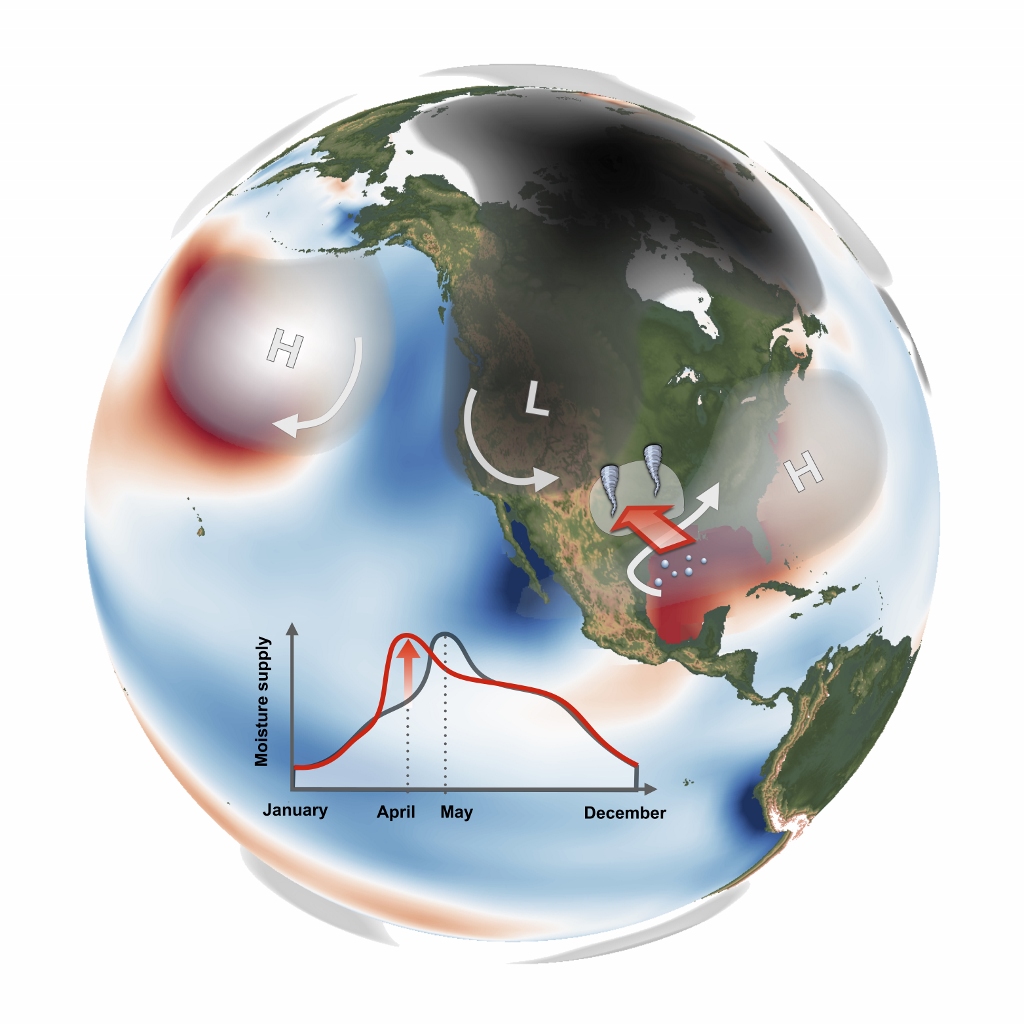New research, published in the journal Science Advances, has found that unusual ocean temperatures in the tropical Pacific and Atlantic can drastically increase April tornado occurrences over the Great Plains region of the United States.

2019 has seen the second highest number of January to May tornadoes in the United States since 2000, with several deadly outbreaks claiming more than 38 fatalities. Why some years are very active, whereas others are relatively calm, has remained an unresolved mystery for scientists and weather forecasters. Climate researchers from the IBS Center for Climate Physics (ICCP), South Korea have found new evidence implicating a role for ocean temperatures in US tornado activity, particularly in April. Analyzing a large number of atmospheric data and climate computer model experiments, the scientists discovered that a cold tropical Pacific and/or a warm Gulf of Mexico are likely to generate large-scale atmospheric conditions that enhance thunderstorms and a tornado-favorable environment over the Southern Great Plains.
This particular atmospheric situation, with alternating high- and low-pressure centers located in the central Pacific, Eastern United States and over the Gulf of Mexico, is known as the negative Pacific North America (PNA) pattern (Figure 1). According to the new research, ocean temperatures can boost this weather pattern in April. The corresponding high pressure over the Gulf of Mexico then funnels quickly-rotating moist air into the Great Plains region, which in turn fuels thunderstorms and tornadoes.
“Previous studies have overlooked the temporal evolution of ocean-tornado linkages. We found a clear relationship in April, but not in May “, says Dr. Jung-Eun Chu, lead author of the study and research fellow at the ICCP.
“Extreme tornado occurrences in the past, such as those in April 2011, were consistent with this blueprint. Cooler than normal conditions in the tropical Pacific and a warm Gulf of Mexico intensify the negative PNA, which then turbocharges the atmosphere with humid air and more storm systems”, explains Axel Timmermann, Director of the ICCP and Professor at Pusan National University.
“Seasonal ocean temperature forecasts for April, which many climate modeling centers issue regularly, may further help in predicting the severity of extreme weather conditions over the United States”, says June-Yi Lee, Professor at Pusan National University and Coordinating Lead Author of the 6th Assessment report of the Intergovernmental Panel on Climate Change.
“How Global Warming will influence extreme weather over North America, including tornadoes still remains unknown “, says. Dr. Chu. To address this question, the researchers are currently conducting ultra-high-resolution supercomputer simulations on the institute’s new supercomputer Aleph.
References
North American April tornado occurrences linked to global sea surface temperature anomalies , J.-E. Chu, A. Timmermann, J.-Y. Lee, Science Advances (2019) doi: 10.1126/sciadv.aaw9950
Media Contact
For further information or to request media assistance, please contact: Ji Kim, IBS Center for Climate Physics, Pusan National University ( (+82-51-510-7691, jikim0204@pusan.ac.kr)
About the Institute for Basic Science (IBS)
The Institute for Basic Science (IBS) was founded in 2011 by the government of the Republic of Korea with the sole purpose of driving forward the development of basic science in South Korea. IBS has launched 28 research centers as of July 2017. There are nine physics, one mathematics, six chemistry, eight life science, one earth science, and three interdisciplinary research centers. Go to the IBS website.
About the IBS Center for Climate Physics (ICCP)
The IBS Center for Climate Physics (ICCP) seeks to expand the frontiers of earth system science by conducting cutting edge research into climate dynamics and utilizing high-performance computer simulations, with the goal of improving decadal Earth system forecasts and long-term projections.
- [CTV News] Strange ocean temperatures may be linked to spring tornadoes in Great Plains: study
- [ScienceBlog] Ocean Temperatures Turbocharge April Tornadoes Over Great Plains Region
- [ScienceDaily] Ocean temperatures turbocharge April tornadoes over Great Plains region
- [dailyheralds] Tornado in May? That’s harder to say
- [The Weather Company] Ocean Temperatures Energize April Tornadoes over the Great Plains, Study Finds
- [Before It’s News] Significant Changes Expected in the Ocean Due to Climate Change, New Study Offers Road Map
- [SCIENMAG] Researcher Hones Model To Forecast Dusty Conditions Months In Advance
- [TechDeeps] Ocean temperatures turbocharge April tornadoes over Great Plains region
- [Science Advances] North American April tornado occurrences linked to global sea surface temperature anomalies
- [EurekAlert] Ocean temperatures turbocharge April tornadoes over Great Plains region
- [Phys.org] Ocean temperatures turbocharge April tornadoes over Great Plains region
- [Cosmos] Tornado in May? That’s harder to say